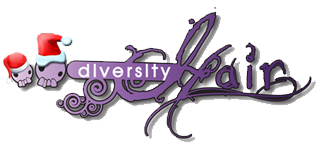Types of Synthetic Fibre
With so many different types of synthetic hair available these days, it is important to make the best selection for your hair project. Traditionally, Kanekalon was the most popular and widely available fibre used in jumbo braid, but as the years have moved on, with a lot more choice of high quality alternative fibres available, it's best to keep 'in the know' about what's available.
At Diversity Hair, we like to offer you a range of choice so you can choose the fibre which is right for you.
Below is a guide to the types of fibre you may come across for sale at Diversity Hair. All of the hair we carry at Diversity Hair can be used to make synthetic dreadlocks and braids of all types. Many of the ranges we stock can also be used for doll hair rerooting. Please be aware that you will need to check our advice on sealing the hair to ensure you achieve best results as some have higher heat resistance than others.
Different types of fibre used in synthetic hair:
Kanekalon® Fibre
Made by the Kaneka Corp, Kanekalon® is a registered Trademark and supplied by them in its raw state to factories to cut, texturise and dye. It has a low heat resistance of around 80 degrees C and shrinks with heat. Flame retardant. It is great for beginner dreadmakers. Kanekalon hair is also a popular choice for doll rerooting. We offer Kanekalon in various brands of jumbo braid and in our pre-stretched range which is tapered for your convenience.
Kanekalon® High Heat Fibre
Simply put, Kanekalon that has been dyed in non standard colours using different processes. This means that the texture and heat resistance are altered. Only a minimal amount of factories do this, and availability is completely dependant on dye availability. This means the Kanekalon has a high heat resistance of around 160 degrees C and upwards, and this will vary across colours in the same range, along with the texture. Usually you'll find this fibre made into Yaki ponytails etc. Flame retardant.
Kanekalon® High Heat FUTURA® Fibre
Another more widely used version of high heat resistance Kanekalon fibre. FUTURA® is made to mimic human hair in texture and heat resistance. You can use heated hair tools on it to style it, and it resists tangling. You would apply it as a weave or as bonded hair extensions. Flame retardant.
Low Temperature Fibre
Much like Kanekalon® but slightly coarser in texture. With a similar heat resistance. It will set in hot water.
Monofiber
Monofiber (sometimes called Henlon) is a type of high heat synthetic fibre often confused with High heat Kanekalon. Its main use in the industry is wig making. Monofiber is generally silky and quite tough. It has a high heat resistance of 120 degrees C and up, and will not shrink with heat, but will hold its shape so is great for crochet dreads but can be used for smooth dreads. The colour spectrum of monofiber is vast so great for festival looks and custom doll rerooting although extra attention is required to get it to curl. Monofiber / Henlon is slick so has a lot less volume in the packet than other synthetic fibres.
High Temperature Fibre
A light puffy fibre that mimics Kanekalon in texture, albeit with slightly more shine. It offers more colour range, and is great for dreadmaking and braids. It is NOT flame retardant, but it does set its shape if high heat is used. You would set it with straighteners over a damp cloth or boiling water.
Saran
Popularly used in the doll hair and rerooting world, Saran is a staple as it offers a wide range of colours, along with colour change (thermal) and glow in the dark varieties. Saran feels limp and slightly waxy and is best used straight. It is widely used in Barbie, My Little Pony and other well known dolls and is high quality.
Toyokalon Fibre
Toyokalon is a flame retardant fibre usually used for wig making. It has a higher heat resistance than Kanekalon, and offers a wide variety of colours. It is particularly good for curled styles as it holds the curl extremely well. Toyokalon is softer than Kanekalon and won't tangle as much. This is only really an advantage when using it in its uncrimped form for loose extensions.
Polypropylene Fibre
Polypropylene was one of the earliest types of synthetic fibre on the market. It is not flame resistant, but does have a high heat tolerance. It is normally shiny in texture. However, it is still used for some special effects hair, as it lends itself very well to this. It can take special effects dyes well and is quite a strong fibre. It is also used as doll hair.
Hiperlon Fibre
Hiperlon is the highest quality synthetic fibre you will find. It is used for wig making and made to be durable, strong and as natural looking as possible. It has a heat resistance of up to 420 degrees C and reacts well to styling and dying.
Powerlon Fibre
Powerlon is very similar to Hiperlon, but slightly softer. It takes high heat styling, but is not as heat resistant as Hiperlon. Again, best used in wig making and one of the most common wig making fibres after Henlon.
Elora and Kanekalon
This is Kanekalon that has been coated. The idea is to make the kanekalon less able to tangle when used in wigs. However, since it is still kanekalon, it can only take low heat styling.
Modlon Fibre
The cheapest and lowest quality of synthetic fibre, it is not heat resistant, and very shiny. It is usually used for party wigs.
Nylon
Popularly used in doll hair, nylon hair comes in a range of colours, curls quite easily and holds its shape. It is slippery to work with and can feel plastic-y and look shiny.
